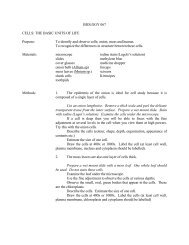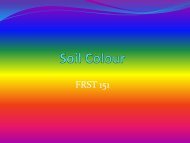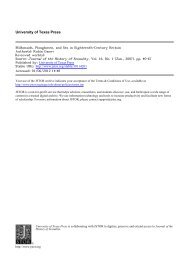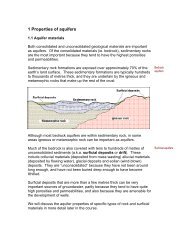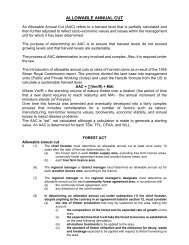FOREST SOILS - web.mala.bc.ca
FOREST SOILS - web.mala.bc.ca
FOREST SOILS - web.mala.bc.ca
You also want an ePaper? Increase the reach of your titles
YUMPU automatically turns print PDFs into web optimized ePapers that Google loves.
<strong>FOREST</strong> <strong>SOILS</strong><br />
<strong>FOREST</strong>RY 151<br />
SOIL TAXONOMY<br />
As everything in science, soils are classified for the purpose of identifi<strong>ca</strong>tion. This way, when someone<br />
describes a soil as being a BRUNISOL, everyone to whom that is communi<strong>ca</strong>ted, within the environmental<br />
sciences, knows (or should know) of what that person speaks.<br />
Generally speaking, there are three (3) mineral horizons (in most <strong>ca</strong>ses) within a soil profile; the "A" at the top<br />
of the profile which is either eluviated (Ae) or humified (Ah) (in some <strong>ca</strong>ses, both <strong>ca</strong>n be found in the same<br />
profile); the "B" horizon lo<strong>ca</strong>ted below the "A" (sometimes, there is more than one "B" horizon) which is an<br />
altered form of the "C", or lower horizon, by pedogenesis; and the "C" horizon which is unaltered (more or<br />
less) parent material. On top of it all, there is an organic horizon referred to as the humus or LFH.<br />
Not all soils are the same; they will vary a great deal in appearance based on the environment in which they<br />
have evolved and the type of material that they evolve from.<br />
Climate very strongly influences the process of soil formation and evolution both directly and indirectly; the<br />
latter by controlling other factors such as plant and wildlife communities. As such, soils are classified,<br />
primarily, according to the powers of influence and what <strong>ca</strong>uses them to be the way they are.<br />
The Canadian System of Soil Classifi<strong>ca</strong>tion<br />
The System of Soil Classifi<strong>ca</strong>tion for Canada has six levels of generalization or <strong>ca</strong>tegories<br />
as outlined below:<br />
Order Level<br />
This is the highest level of generalization. The pedons (the smallest 3 dimensional unit of soil that<br />
<strong>ca</strong>n be used for classifi<strong>ca</strong>tion purposes - generally 1 - 2 m deep by 1 - 3.5 m wide) are grouped<br />
according to their properties that reflect the nature of the soil forming processes. For<br />
example, the total effect of soil processes in the soils of the Chernozemic order leads mainly to<br />
the accumulation of organic matter in the topsoil under grassland vegetation. The number of<br />
specific statements that <strong>ca</strong>n be made about this <strong>ca</strong>tegory are few; only general statements are<br />
possible. Ten orders are recognized, eight for mineral soils, one for organic soils, and one which<br />
<strong>ca</strong>n contain both.
Great Group Level<br />
This class is a subdivision of the order and is, therefore, more specific and more precise<br />
statements <strong>ca</strong>n be made about it. Great groups are based on properties that reflect<br />
differences in the strength of the dominant processes or a major contribution of a process<br />
in addition to the dominant one. In the Chernozemic order the great groups are differentiated<br />
on the basis of the colour of the topsoil. This is an indi<strong>ca</strong>tion of the amount of organic matter that<br />
has accumulated. The Brown soils in the driest areas have the least and the Black soils in the<br />
coolest and wettest areas have the most. The Dark Gray soils occur near the forest-grassland<br />
transition where a secondary process of the leaching of organic matter and clay from the topsoil<br />
becomes important.<br />
Subgroup Level<br />
A subdivision of the great group that defines the central concept of the great group (Orthic) or<br />
certain variations from that concept which are grading towards other orders, e.g. a Gleyed Brown<br />
Chernozemic or a Solonetzic Brown Chernozemic, where the normal features of a Brown<br />
Chernozemic soil are being modified by the occurrence of excessive water or soluble salts<br />
respectively. Special features of the soil profile such as thin iron pans (Placic) or repeated organic<br />
layers (Cumulic) are also used to classify sub-groups. The subgroup is visualized as having a<br />
particular assemblage of horizons and the Canadian System of Soil Classifi<strong>ca</strong>tion specifies the<br />
horizons that each subgroup <strong>ca</strong>tegory must have, along with others that it may have.<br />
Family Level<br />
A subdivision of the subgroup which identifies a group of soils that are relatively homogeneous in<br />
mineralogy, texture and soil climate as well as genetic soil horizons. Be<strong>ca</strong>use of the more precise<br />
nature of this class many statements <strong>ca</strong>n be made about the use and management of the soils in<br />
relation to plant growth, hydrology and engineering characteristics.<br />
Series Level<br />
A subdivision of the family, this is a group of pedons (a polypedon) with horizons whose features<br />
such as colour, texture, structure and thickness fall within a narrow range. The pedons have all<br />
been developed from similar parent material. This is probably the most important <strong>ca</strong>tegory of soils<br />
for consideration of use and management since it applies to real soil bodies - polypedons.<br />
There used to be a further <strong>ca</strong>tegory <strong>ca</strong>lled a TYPE based on the texture of the topsoil. This has<br />
now been dropped but may be found in some early reports.<br />
The higher classes of the Soil Classifi<strong>ca</strong>tion (order, great group, subgroup and family) are<br />
especially important in studying genetic relationships, drawing inferences and allowing<br />
correlations which are often required for regional studies. The two lower <strong>ca</strong>tegories are more<br />
suited to lo<strong>ca</strong>l and site specific studies and to land utilization programs.<br />
The nomenclature used for the four higher <strong>ca</strong>tegories is descriptive of either the soil morphology<br />
or the kinds of environments in which the soils are found. The soil series, be<strong>ca</strong>use of its more lo<strong>ca</strong>l<br />
character and precise nature, is named after a geographic or cultural feature near the site where<br />
the soil was first observe.
The classifi<strong>ca</strong>tion system down to this level is as follows:<br />
Order Great Group General Description<br />
Brunisolic<br />
Podzolic<br />
Cryosolic<br />
Gleysolic<br />
Luvisolic<br />
Organic<br />
Regosolic<br />
Chernozemic<br />
Solonetzic<br />
Dystric Brunisol<br />
Eutric Brunisol<br />
Sombric Brunisol<br />
Melanic Brunisol<br />
Humic<br />
Ferro-humic<br />
Humo-ferric<br />
Organic Cryosol<br />
Static Cryosol<br />
Turbic Cryosol<br />
Humic Gleysol<br />
Gleysol<br />
Luvic Gleysol<br />
Gray Brown Luvisol<br />
Gray Luvisol<br />
Fibrosol<br />
Mesisol<br />
Humisol<br />
Folisol<br />
Regosol<br />
Humic Regosol<br />
Brown<br />
Dark Brown<br />
Black<br />
Dark Gray<br />
Solod<br />
Solodized Solonetz<br />
Solonetz<br />
Vertisolic No Great Groups<br />
These soils are common in milder forest environments such as the south<br />
coast. They tend to be marginally developed soils as demonstrated by the dull<br />
brown "B" horizons. They could be classified as transitional soils between<br />
REGOSOLS and some other great group such as PODZOLS.<br />
Podzols have "B" horizons with various accumulation levels of humified<br />
organic materials and Al and/or Fe (Bh/Bhf/Bf), and tend to occur in cooler<br />
wetter coniferous forest environments.<br />
Soils that have permafrost within one metre of the surface.<br />
These soils tend to be saturated for prolonged periods of time and, as such,<br />
tend to experience intense reduction. They have a characteristic low chroma<br />
or have very prominent mottles of high chroma within 50 cm of the surface.<br />
These soils are common in depressions with poor drainage.<br />
These soils have strongly illuvial "B" horizons in which high levels of clay has<br />
accumulated (Bt) and demonstrate the "classic" clay skins on the peds.<br />
These soils are composed of at least 40 cm of organic materials that are<br />
saturated for extended periods of time.<br />
These are very young, poorly developed, soils and lack a genetic horizon.<br />
These are typi<strong>ca</strong>l prairie or grassland soils with dark "Ah" horizons greater<br />
than 10 cm thick with a base saturation greater than 80%.<br />
These soils are common in areas were the parent material is saline. They<br />
tend to be quite hard when dry and very sticky when wet and demonstrate the<br />
classic columnar or prismatic macrostructure.<br />
These are soils developed on Aheavy@ clay parent materials composed mainly<br />
of smectite - a swelling type clay. As a result, the soil tends to shrink and<br />
expand quite signifi<strong>ca</strong>ntly resulting in prominent verti<strong>ca</strong>l cracking obliterating<br />
well-defined horizons. Common on the prairies and east of the Rocky<br />
mountains in BC.<br />
THE MOST COMMON SOIL ORDERS OF BRITISH COLUMBIA<br />
THE BRUNISOLIC ORDER<br />
Soils of the Brunisolic order have undergone only moderate development from the original parent<br />
material. Physi<strong>ca</strong>l, chemi<strong>ca</strong>l and biologi<strong>ca</strong>l weathering has proceeded far enough to change the<br />
morphology of the parent material. There are no drastic translo<strong>ca</strong>tions or transformations of the<br />
material that characterize many of the other orders.<br />
There are a number of reasons for this type of soil occurring in British Columbia. Firstly in many<br />
areas the climate has restricted the progression of soil weathering. Long winters and low<br />
temperatures restrict the rate of many of the transformations which constitute soil weathering.<br />
This is the reason why Brunisolic soils cover much of the high plateaus of central and northern<br />
British Columbia. Lack of soil moisture also limits transformations such as chemi<strong>ca</strong>l weathering.<br />
Thus, Brunisolic soils are also found in the sub-humid to semiarid zones of the southern interior.<br />
Secondly, some Brunisolic soils have developed on very coarse textured materials such as
fluvio-glacial sands and gravels in areas where the climate is not normally a limiting factor in soil<br />
development. Be<strong>ca</strong>use clay-sized particles, the principal active fraction in chemi<strong>ca</strong>l<br />
transformations, make up only a small volume of the total mineral soil, little weathering has taken<br />
place. Most of the soil is relatively inert gravel and quartz sand. Moreover the parent material has<br />
a low water-holding <strong>ca</strong>pacity, so that soil water content is low and thus chemi<strong>ca</strong>l transformations<br />
are further restricted. The droughtiness of these soils means that the vegetation is often limited to<br />
open lodgepole pine and pinegrass in the interior. Therefore, organic matter additions to the<br />
topsoil are limited, and well-structured Ah horizons are thin or absent. Thirdly, Brunisolic soils are<br />
found on very young geologi<strong>ca</strong>l sediments. In this <strong>ca</strong>se the time available for soil development<br />
since deposition has not been sufficient for anything more than a moderate amount of weathering<br />
to have taken place. Many of the soils on the recent alluvium of the Fraser Valley fall into the<br />
Brunisolic order.<br />
Soils of the Brunisolic order are often regarded as being in a transitional stage of development.<br />
We think that given time, the translo<strong>ca</strong>tion of weathered products will begin within the soil to<br />
produce Podzols or possibly Luvisols. The Brunisolic soils on Fraser River alluvium are a<br />
probable example. However, there are many areas in British Columbia where Brunisolic soils<br />
occur on sediments that have been exposed to sub-aerial weathering since the ice melted about<br />
11,000 years ago; for example the soils in the semiarid southern interior valleys. In other words, it<br />
is necessary to decide whether transitional is to mean in the short or in the long term.<br />
The main processes involved in the formation of Brunisolic soils are the removal by<br />
leaching of soluble salts and <strong>ca</strong>rbonates, the in situ weathering of the mineral fraction to<br />
form secondary minerals and hydrated iron and aluminum oxides, and the development of<br />
soil structure in the finer textured materials that is different from the original structure of<br />
the parent material. These are the processes that form the Bm horizon which is diagnostic<br />
of Brunisolic soils. In the field it is recognized by its browner or redder colour as<br />
compared with the parent material, by its structure and by its lack of major accumulations<br />
of any materials translo<strong>ca</strong>ted from the A horizon, such as clay. A common horizon<br />
sequence for these soils would be LFH, Ah, Bm, C or Ck.<br />
The great groups of the Brunisolic order are separated on the basis of the presence or absence of<br />
an A horizon in which the mineral and organic fractions have been mixed together by soil fauna<br />
(an Ah horizon), and on the base status of the soils as shown by the pH. The Ah horizon indi<strong>ca</strong>tes<br />
that there is a net addition of organic matter to the soil and that organic nutrients are available. A<br />
high base status shows that the soil <strong>ca</strong>n retain inorganic nutrients such as <strong>ca</strong>lcium and potassium,<br />
or that leaching is limited. The specific characteristics of the four great groups are as follows:<br />
Melanic Brunisol: Thick Ah horizon + high base status (pH over 5.5)<br />
Eutric Brunisol: No or thin Ah horizon + high base status (pH over 5.5)<br />
Sombric Brunisol: Thick Ah horizon + low base status (pH. less than 5.5)<br />
Dystric Brunisol: No or thin Ah horizon + low base status (pH less than 5.5)<br />
THE PODZOLIC ORDER<br />
Soils of the Podzolic order have been formed under subarctic to cryoboreal and perhumid<br />
to humid soil climates. Their parent materials are mostly coarse textured and well drained.<br />
They contain much sili<strong>ca</strong> and few bases such as <strong>ca</strong>lcium or magnesium <strong>ca</strong>rbonate. The<br />
vegetation growing on them is usually coniferous forest, but some Podzolic soils develop under<br />
heather (alpine).<br />
Under these conditions there is an abundance of water moving through the soil during the year.<br />
Chemi<strong>ca</strong>l and biologi<strong>ca</strong>l transformations are intense in the upper horizons. Organic matter is<br />
decomposed and primary minerals are broken down releasing iron and aluminum in the
non-<strong>ca</strong>l<strong>ca</strong>reous (soils with limited amounts of <strong>ca</strong>lcium <strong>ca</strong>rbonates) soil environment. These three<br />
weathering products are readily moved out of the A horizon and into the B in the porous parent<br />
materials. It is the accumulation, in various combinations, of organic matter, iron and<br />
aluminum in the B horizon that is the distinguishing characteristic of Podzolic soils.<br />
Podzolic soils have a striking appearance. There is a black LFH organic litter layer on the<br />
surface under which the top of the mineral soil is light gray. This is the Ae horizon from<br />
which bases, organic matter, iron and aluminum have been translo<strong>ca</strong>ted down into the B<br />
horizon. There is little left apart from sili<strong>ca</strong> silt and sand. The B horizon is in sharp contrast, a<br />
reddish brown layer enriched with organic matter, iron and aluminum, the colour<br />
becoming more yellow with depth. A typi<strong>ca</strong>l horizon sequence would therefore be LFH, Ae,<br />
Bhf, Bf, BC, C.<br />
There are some variations of this classic podzol profile in British Columbia. In many areas<br />
of coastal forest there is no bleached Ae horizon in the profile. The addition of organic matter<br />
to, and the weathering of iron and aluminum in, the upper mineral horizon is so great that despite<br />
the heavy leaching there is no net depletion to form an Ae horizon. In other areas the organic<br />
matter simply masks the Ae horizon under moist field conditions.<br />
Many of the Podzolic soils of the west coast mountains have compacted horizons in the subsoil.<br />
These may be at various depths, have varying thicknesses and contain different cementing<br />
agents. They are given different names - ortstein, placic, duric or fragic - according to their<br />
morphology and mode of origin. They have the common effect of restricting root penetration and<br />
permeability.<br />
Over much of southern British Columbia, especially in the mountains, vol<strong>ca</strong>nic ash makes<br />
up a signifi<strong>ca</strong>nt proportion of the topsoil. As it weathers, the ash releases large amounts<br />
of iron and especially of aluminum. When the iron and aluminum are translo<strong>ca</strong>ted into the<br />
B horizon a Podzolic soil profile is produced. This <strong>ca</strong>n happen in areas that do not have a<br />
typi<strong>ca</strong>lly high rainfall, nor dense conifers nor an acid bedrock. The profile has been formed<br />
be<strong>ca</strong>use the parent material was able to supply large quantities of moveable iron and aluminum.<br />
The result is an example of comparable soils being formed in two different environments where<br />
the lack of one factor is compensated for by the excess of another.<br />
There are three great groups in the Podzolic order. They differ according to the relative amounts<br />
of organic matter and iron plus aluminum that have accumulated in the upper B horizon as<br />
follows:<br />
Humic Podzol: Accumulation of organic matter with a limited supply of Fe to give a Bh<br />
horizon. These soils occur in wet environments such as the coastal forests<br />
or at high elevations inland; common on the BC coast.<br />
Ferro-Humic Podzol: Accumulation of organic matter Fe plus Al to give a Bhf horizon. These<br />
soils occur under humid coniferous forest conditions on the west coast<br />
where there is often a thick ground cover of moss.<br />
Humo-Ferric Podzol: Accumulation of Fe plus Al and little organic matter to give a Bf<br />
horizon. These soils occur in less humid or cooler areas than the other<br />
two great groups such as higher elevations on the eastern side of<br />
Vancouver Island or the subalpine forests of the interior.
HORIZON QUALIFIERS<br />
Due to pedogenesis, soil horizons will vary in their physiologi<strong>ca</strong>l make-up from soil order to soil order. To note<br />
these differences, lower <strong>ca</strong>se suffixes are used. Of the twenty qualifiers used, the following are the most<br />
common.<br />
c Denotes a cemented horizon.<br />
e A horizon characterized by the eluviation of clay, Fe, Al, or organic matter. Used with the "A"<br />
horizon<br />
f A horizon enriched with Al and Fe combined with organic matter. It usually has a hue of 7.5<br />
YR or redder. Used with the "B" horizon.<br />
g Denotes a gleyed horizon. Characterized by grey colours, or prominent mottling. Can be<br />
used with the B and/or C horizons.<br />
h A horizon enriched with organic matter. Used with either the "A" or "B" horizons.<br />
m A horizon slightly altered by hydrolysis, oxidation or solution, or all three. Used with the "B"<br />
horizon when it is slightly redder or brighter than the underlying material.<br />
t An illuvial horizon enriched with sili<strong>ca</strong>te clays. Used with the "B" horizon.<br />
j A modifier of suffixes such as f, e, t, m, g, h, used to denote that the horizon does not quite<br />
meet the criteria of the suffix it is used with.<br />
n A horizon in which the ratio of exchangeable Ca to Na is less than 10. The horizon must also<br />
have prismatic or columnar structure, dark coatings on the peds, and hard to very hard<br />
consistence when dry. It is used with B master horizons.<br />
Other qualifiers include s for salts, k for <strong>ca</strong>rbonates, p for disturbed by man, z for frozen, y for affected by<br />
cryoturbation, and u for markedly disrupted by physi<strong>ca</strong>l or faunal activity such as blowdown, mass movement,<br />
or burrowing animals.



